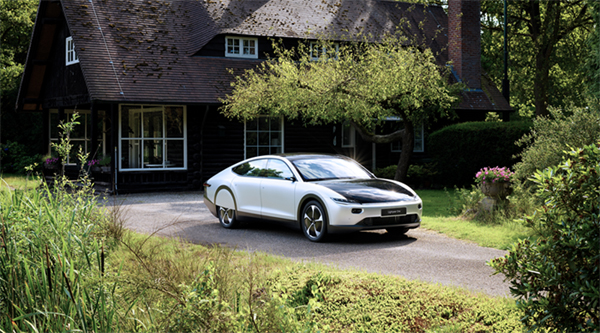|
|

|
  
Top Stories
Update 2019/7/21
Technology
This story is brought to you in part by

LIGHTYEAR ONE∞ THE WORLD'S FIRST LONG-RANGE SOLAR CAR
By Suzanne Forcese

Lightyear One - Photo courtesy Lightyear
Imagine a clean mobility car that is powered by the sun. What would it be like to be completely independent of the infrastructure required to fuel or charge a vehicle? A vehicle light years ahead of its time that has scrapped the rules of convention but followed the laws of physics with legendary Italian design. A car that cuts through the air like a raindrop. WaterToday had the privilege of connecting with the team that is making this a reality.
The team, based in The Netherlands, is a mix of young creative talent and seasoned expertise from Tesla and Ferrari -- a team that uses the latest technology to fast-forward to a new age. "We started with a blank piece of paper," said Lex Hoefsloot, CEO at Lightyear, who has built the company from 5 people to 140 in 2 years. On June 25, 2019, Lightyear, introduced the first long-range solar car, a prototype to a select audience of investors.
Hoefsloot emphasizes the importance of the moment. "Climate change is one of the biggest problems that we humans have faced in history. It is such a frightening development that it is almost paralyzing. As engineers, we believed we could do something. Lightyear One∞ represents a huge opportunity to change mobility for the better." Hoefsloot stressed that nature has been a great source of inspiration. "For centuries, we have lived in balance with nature. With the technologies of today, we have the opportunity to do so again. By starting from scratch and using the laws of nature as a guideline, nature becomes our greatest ally in developing ultra-efficient designs."
Hoefsloot adds that the idea had its genesis seven years ago. "For the past two and a half years we've pushed electrical, mechanical material and design philosophies past their boundaries to make the first long-range solar car. Our
engineers have invented new solar cells and in-wheel engine technologies to create revolutionary range and efficiency. We also partnered with an Italian design studio to ensure the appearance of Lightyear One is as world-class as is its technology."
"For us, this prototype launch feels like the starting point of a new era. In the next phase of our journey, we will continue to push boundaries to bring Lightyear One to the market and onto the road toward a sustainable future."
Henk de Bruin, Sustainability Advisor, adds, "In our efforts to support the reduction of global warming, the benefits of an electric vehicle with no tailpipe emissions are clear. That benefit is enlarged substantially if that car is solar driven because additional charging from the grid can be limited to none." Depending on geography, indirect CO2 emissions of electric power plants supplying grid charging can be low or even zero if coming from renewable sources.
Lightyear also looked at carbon emissions that occur during the making of a car and at the end-of-life of a vehicle. The Lightyear One stands out in CO2 reduction during the "use phase" because it has its own solar cells on board all the time and only needs limited charging from the grid. Compared to a gasoline car, an electric vehicle has a larger carbon footprint in the "production phase" and "end-of life" phase caused by the production and recycling of the battery pack. The Lightyear One has a slightly lower carbon footprint in production because it utilizes a relatively small battery pack while still providing a broader range.
Lightyear 's main goal is to fill in where electric cars fall short. Research has shown that range and lack of charging options are still the top concerns. Engineered from a radically different perspective, Hoefsloot elaborated, "We are solving these issues with what we call ultra-efficiency on one hand, that will lead
to an exceptional range of 725 km (WLTP) on a relatively small battery. On the other hand, it can charge directly from the sun because its energy consumption is much lower, generating up to 20,000 km worth of energy per year. Moreover, all of the charging options out there become easier to use because you get a lot more range for the same amount of energy charged. You charge a lot faster from any power outlet, up to 400 km per night from ordinary 230V sockets. That's great for road trips because you don't need charging infrastructure."
Lightyear also sees the transition from a linear to a circular economy as a necessary and complementary boundary condition. A circular economy aims to decouple economic growth from the use of natural resources and ecosystems. Moreover it is a driver for innovation. "Within Lightyear," de Bruin adds, "our approach for materials choices, parts design, car assembly and the development of business models, incorporate the Circular Economy."
Wiebe Janssen, Powertrain Engineer discussed the design of in-wheel motors. "By elimination the transmission, we minimize needless energy loss. The car becomes lighter and therefore requires less energy." By reducing the amount of maintenance needed, the car becomes cost effective over its life cycle. In-wheel motors drastically reduce the amount of moving parts and with that the need for maintenance. Another convenience is the extra space. Small distributed motors free up a lot of space within the car.
"We wanted the car to be independent from the grid and the road network. Individual and precise control over each wheel is necessary to enable off-road driving. The complete drive train allows for this." Lightyear is also developing a novel power train platform that will create new possibilities for the models to come. "We have stringent requirements for efficiency, weight and torque."
Aerodynamics is another important factor in the design and performance of the Lightyear One. Annemiek Koers, Aerodynamics Engineer, contributed important insights. "With aerodynamics we study how well the air flows around the car. Our job is to ensure the air moves along the curves of the car as smoothly as possible. We stop the air from moving in swirls into holes or interstices thus reducing the friction between the car and the air." Since the solar panels do not have an infinite surface and the object is to use the available energy as efficiently as possible, the car needs to glide through the air with low resistance. The less energy the car uses moving through air, the farther the car will go. "This focus sets us apart from other car manufacturers." The resistance co-efficient of the car times the frontal surface , called the Coefficient of the Drag Area , or CD, is a value used to indicated the aerodynamic performance of the car. "Right now the CD is below 0.20, well below the current market leaders. We are always looking for things that will lower the air resistance even further so we get closer to our ultimate resistance goal."
The most intriguing feature of the car is the design of the solar roof. WT was brought up to speed on this unique feature by photovoltaics engineer, Simone Regondi. "Currently we are mainly focusing on process optimization, improving technology, maturity level, and bringing parts to manufacturing quality." The solar roof is composed of three main elements. The top layer, made of glass protects the solar cells while letting light in and gives a smooth surface to the roof. The second layer is the photovoltaic (PV) module containing the solar cells. This module is laminated together with the third element, the supporting structure. The unique curvature of the solar roof maximizes the aesthetics and aerodynamic performance.
Predicting the energy yield is always a challenge for vehicle-integrated photovoltaics because of the changing environment. This includes weather conditions, time, and location. Regondi gives an example of a round- trip from
Amsterdam to Innsbruck (1802 km) that takes into account solar area and shadow. "You would only have to charge the car twice." There is a calculator on the website. To understand another example –"On an empty battery you can drive through one hour of noonday summer sun for 15 km to get to any power outlet in order to start charging at the same speed a normal EV would do at a special charging station."
Chief Design Engineer and cofounder of Lightyear, Koen van Ham, stated, "Our main goal is to change how people relate to vehicles. The appeal of the car is the freedom that it offers the primal call of the open road. We aimed for timeless, minimalistic design with minimal impact on the environment."
"Since new technology has a high unit cost," Lex Hoefsloot added, "we have to start with an exclusive market. The next models we plan to develop will have a significantly lower purchase price that we will provide to autonomous and shared car fleets so the purchase price can be divided amongst a large group of users. Combined with the low operating costs of the vehicle, we aim to provide premium mobility for a low price per kilometer. The final step will be to provide truly sustainable cars that are more affordable to use than the cost of gas you need to drive a combustion car. This will be our most important tipping point in the near future – a fleet that is 100% sustainable."
Lightyear will be ramping up production of the Lightyear One∞ in 2021. The first 100 cars have already been reserved. Buyers can now reserve one of the 500 cars for a fee of €119,000 (CAD $175,000). Delivery will be early 2021.
suzanne.f@watertoday.ca
|
|
|
Have a question? Give us a call 613-501-0175
All rights reserved 2025 - WATERTODAY - This material may not be reproduced in whole or in part and may not be distributed,
publicly performed, proxy cached or otherwise used, except with express permission.
|
| |